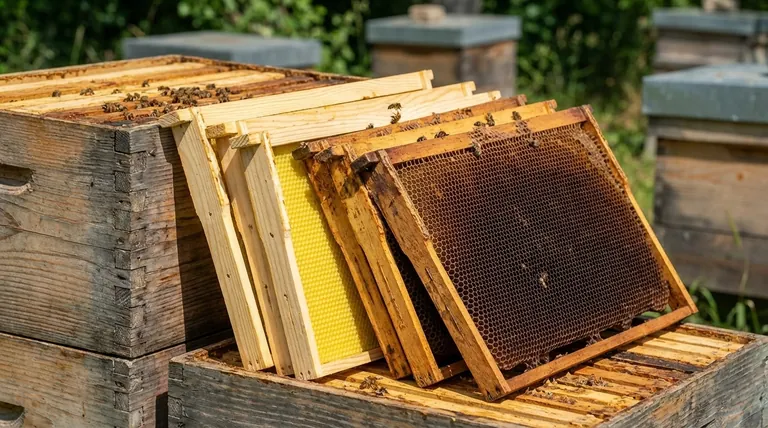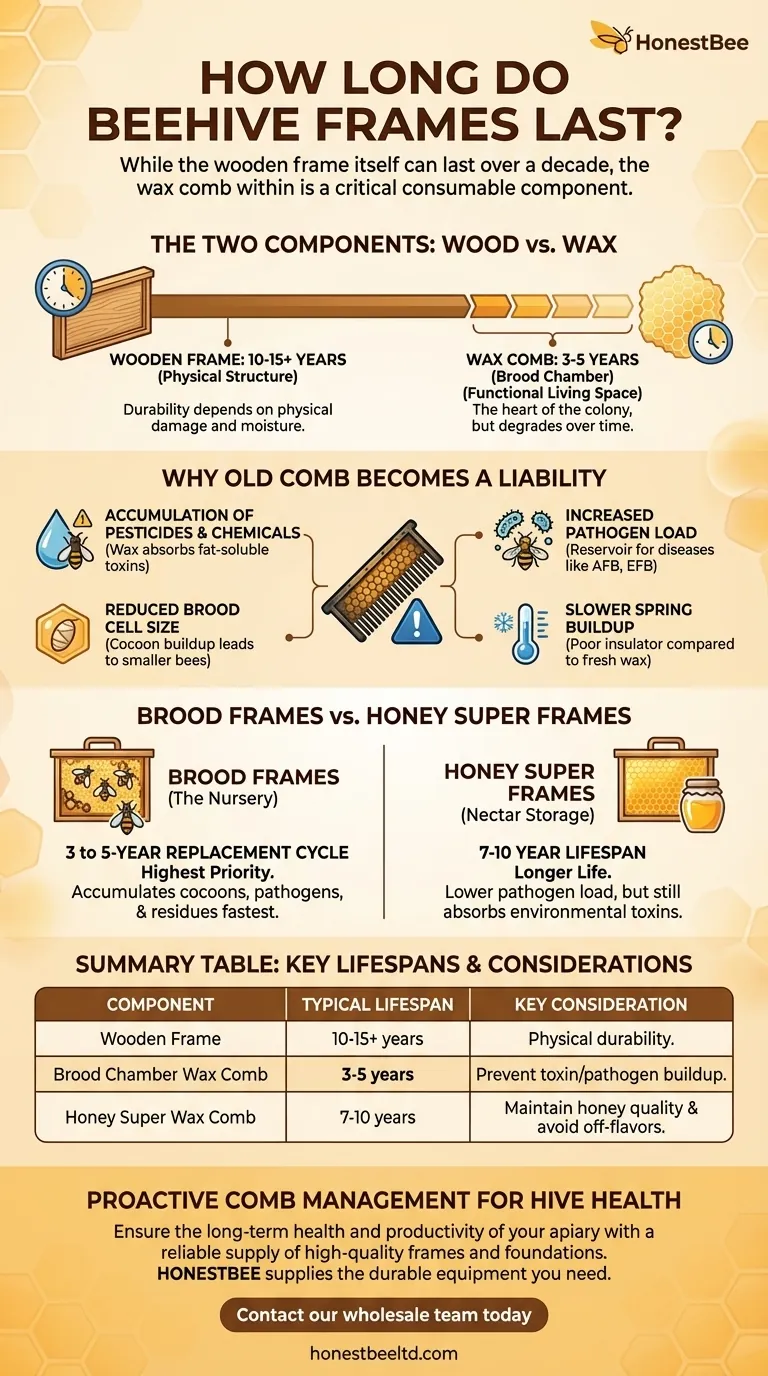While the wooden frame itself can last over a decade, the critical component is the wax comb within it, which has a much shorter functional lifespan. For the health and productivity of your colony, the comb, especially in the brood chamber, should be considered a consumable item that requires regular replacement.
The core issue is not the physical durability of the wooden frame, but the biological integrity of the wax comb. Proactive beekeepers rotate old comb out of the hive every 3-5 years to prevent the accumulation of toxins and diseases, ensuring the long-term vitality of their bees.

The Two Components: Wood vs. Wax
To understand a frame's lifespan, you must distinguish between its two parts. The woodenware provides structure, while the wax comb is the functional living space for the bees.
The Lifespan of the Wooden Frame
The physical wooden frame, if well-maintained, can easily last 10-15 years or more. Its lifespan is primarily determined by physical damage from hive tools, breakage during extraction, or eventual rot if exposed to excessive moisture.
However, the wood's durability is secondary to the condition of the comb it holds.
The Critical Lifespan of the Wax Comb
The wax comb is the heart of the colony, but it degrades over time. A responsible beekeeper should plan to rotate out frames, particularly in the brood nest, every 3-5 years. This practice is known as comb rotation.
Why Old Comb Becomes a Liability
New, clean wax is a healthy environment. Old, dark comb becomes a source of chronic stress and potential danger for the colony.
Accumulation of Pesticides and Chemicals
Beeswax is lipophilic, meaning it readily absorbs fat-soluble chemicals. Over years, pesticides, herbicides, and in-hive mite treatments (miticides) build up in the comb, creating a toxic environment for developing brood.
Increased Pathogen Load
Old comb acts as a reservoir for pathogens. Spores from diseases like American Foulbrood (AFB), European Foulbrood (EFB), and Chalkbrood can persist in the wax for years, leading to recurring infections.
Reduced Brood Cell Size
Each time a bee is raised in a cell, it leaves behind its pupal cocoon. Over many generations, this buildup thickens the cell walls and slightly reduces their diameter, which can result in smaller, potentially less vigorous adult bees.
Slower Spring Buildup
Dark, old comb is a poor insulator compared to fresh, light-colored wax. It takes more energy for the colony to keep this comb warm, which can slow down the queen's laying rate and the colony's overall expansion in the spring.
Brood Frames vs. Honey Super Frames
Not all frames are used equally, so their replacement schedules differ.
Brood Frames: The Highest Priority
The brood chamber is the nursery of the hive and experiences the most intense use. Because of the constant brood-rearing cycle, these frames accumulate cocoons, pathogens, and chemical residues fastest.
These frames should be on a strict 3 to 5-year replacement cycle.
Honey Super Frames: A Longer Lifespan
Frames in honey supers are used only for nectar storage. Since no brood is raised in them, they do not accumulate pupal cocoons and have a lower pathogen load.
While they can last longer, perhaps 7-10 years, they still absorb environmental toxins. Old honey-super comb can also impart dark colors and off-flavors to light honey.
Making the Right Choice for Your Goal
Implementing a simple system for tracking frame age is one of the most effective management practices for promoting hive health.
- If your primary focus is maximum hive health and disease prevention: Implement a strict 4-year rotation for all brood frames, removing the two oldest frames from each brood box annually.
- If your primary focus is simplicity and cost-effectiveness: Aim for a 5-year rotation in the brood box. Use different colored push-pins or a permanent marker on the top bar to denote the year each frame was introduced.
- If your primary focus is pristine honey quality: Cycle out your honey super frames every 7-10 years to prevent discoloration and the transfer of off-flavors from old, dark comb.
Proactive comb management is a direct investment in the long-term resilience and productivity of your bees.
Summary Table:
| Component | Typical Lifespan | Key Consideration |
|---|---|---|
| Wooden Frame | 10-15+ years | Durability depends on physical damage and moisture. |
| Brood Chamber Wax Comb | 3-5 years | Critical replacement cycle to prevent toxin/pathogen buildup. |
| Honey Super Wax Comb | 7-10 years | Replace to maintain honey quality and prevent off-flavors. |
Ensure the long-term health and productivity of your apiary with a reliable supply of high-quality frames and foundations.
As a commercial beekeeper or equipment distributor, proactive comb rotation is key to disease prevention and honey quality. HONESTBEE supplies the durable, dependable beekeeping equipment you need to implement an effective comb management system.
Contact our wholesale team today to discuss your specific needs and keep your operations thriving.
Visual Guide

Related Products
- Assembled Wooden Bee Frames with Beeswax Foundation Ready to Use by HONESTBEE
- HONESTBEE Wired and Assembled Wooden Bee Frames Foundation for a Thriving Hive
- Assembled Wooden Bee Frames with Plastic Foundation for Durability and Convenience by HONESTBEE
- Wholesales Dadant Size Wooden Bee Hives for Beekeeping
- Professional In-Hive Bee Feeder HONESTBEE Frame for Beekeeping
People Also Ask
- How do wooden frames perform during honey extraction? Superior Rigidity for a Smoother Harvest
- How many frames fit in a 10 frame hive? A Guide to Maximizing Your Hive's Potential
- What are some tips for setting up hive frames? Build a Strong Foundation for Your Hive
- What are the main parts of a hive frame? A Guide to Modern Hive Anatomy
- How are Langstroth beehive frames assembled? A Step-by-Step Guide for a Durable Hive



















